Yes, I see your point. Tweaking it for a specific setup doesn't have to apply for another setup. That is the reason for me building another one  which allows me to have one on the bench at any time.
which allows me to have one on the bench at any time.
Still it is nice to know what differences things offers - maybe I will build and tweak theese for living soon... Who knows. I want to add that my tweaking is not based on that I'm unsatisfied with the sq - not at all - I'm very satisfied indeed but with a curious mind
Regards
Still it is nice to know what differences things offers - maybe I will build and tweak theese for living soon... Who knows. I want to add that my tweaking is not based on that I'm unsatisfied with the sq - not at all - I'm very satisfied indeed but with a curious mind
Regards
Last edited:
P.S. For those with Rega arms which are popular models, keep in mind they do better around the Baerwald/Loefgren A geometry and the 66mm/121mm null points protractors are trusty to follow. If settling the tip 1.27mm behind the dots to the right along their ride line then you got the "Guru" Allen Wright endorsed alternative.
Do you have info on the arm manufacturer's effective length/overhang/null points recommendations? If yes use those despite any protractors. Crucial for average brightness or sibilance due to mistracking.
Thanks Salas. Old school Lenco arm - actually 2 of them in superb order on L75's tweaked to my liking. Totally silent when up to speed - some groaning turning the table the first sec - then - utter silence. They are set up to the best of knowledge by information from several sites. And add to this a lot of tests regarding weight and angles. But still, I agree that I need to replace the plinths - they are original with added weight here and there.
When temperatures allow working outside I will build new plinths - IF I find the instructions that I feel happy with. That will be the starting point to that project - I have the framework set up in my mind.
But to come to some kind of point - for different setups the simplistic can only be tweaked by the load - the rest is tweaked up to the standard of my ears (liking maybe would be better?)
Regards
Last edited:
Announced by Purite Audio on pfm.I've asked for a price on the 0.1uf a couple of hours ago but haven't had a reply as yet.There post doesn't say whether its for trade only or not.
Thanks for the info.
Thanks Salas. Old school Lenco arm - actually 2 of them in superb order on L75's tweaked to my liking. Totally silent when up to speed - some groaning turning the table the first sec - then - utter silence. They are set up to the best of knowledge by information from several sites. And add to this a lot of tests regarding weight and angles. But still, I agree that I need to replace the plinths - they are original with added weight here and there.
When temperatures allow working outside I will build new plinths - IF I find the instructions that I feel happy with. That will be the starting point to that project - I have the framework set up in my mind.
But to come to some kind of point - for different setups the simplistic can only be tweaked by the load - the rest is tweaked up to the standard of my ears (liking maybe would be better?).
Regards
Those Lenco have a strong on-line fan club so details should be well accessible.
Remember, the FSP gives C2Y area to tweak also when the things get out of hand beyond the DIP facility to try with loading first.
Those Lenco have a strong on-line fan club so details should be well accessible.
Remember, the FSP gives C2Y area to tweak also when the things get out of hand beyond the DIP facility to try with loading first.
BTW, I ended up with 45.3/45.2pF for C2Y and my C2 is 14.951/14.953pF.
I do believe that I have very natural sound now.
All my prior attempts to use calculated (15.2nF) values are ended with nice bass, but very dull mid and no highs. I assume that final harmony might be related to the type and brands of C3 and C4 also. I use Mundorf SIO for both.
guess this is why I deviated from 15.2nF.
Maybe you compensated for tone elsewhere in your system, speakers-room combination included, because you went for less C2Y (~15nF=(C2+C2Y)) meaning you asked for bit more high mid & treble. I.e. Contrary to Turbon and AnalogSA as they were saying SIO was bright to them in their systems. Could be the cart & arm VTA or the damping between the SE tube amp and speakers etc. etc. So having RIAA EQ flexibility in the FSP helped a lot whatever the root cause(s). Nice feature, it proved not just a minor intervention, it worked. So you better not tamper with C3, C4 values or types in the future unless a system upgrade will throw the balance off. For you SIO went like hand in glove and you are fully set now.
Yes that's what I thought.
I finally settled on 156pf for C2Y;sounding very nice now.I have still to buy better slightly bigger cases so that I can use my Component Research Teflon cap at C3 and the beer can sized Ampohm at C4.How much difference they will make I will have to wait and see.
I finally settled on 156pf for C2Y;sounding very nice now.I have still to buy better slightly bigger cases so that I can use my Component Research Teflon cap at C3 and the beer can sized Ampohm at C4.How much difference they will make I will have to wait and see.
Air dialectic trimmer caps are good of course if fitting the C2Y area. Another thing influential regarding treble tone beyond the usual arm & cart geometry stuff is absolute platter speed. Using a test record with a sinewave tone, usually 300Hz or 1kHz, hook up the DMM in AC mode + Hz mode on the FSP's output, or the line preamp's output. See if the TT is slow or fast and trim it for showing the exact test tone frequency. Given there is some pitch trimmer or slider or fine belt step provision. Not only it fixes the tempo, it nails the overtones too. That's the simplest reliable way I had found. If the DMM is too jumpy its maybe due to fast update rate or it needs more signal. The affordable UNI-T UT61E for instance works fine for that purpose.
Yes nezbleu. Please report and show us a picture of it.
Regards
I got the cart today. It appears to be in excellent condition. I took a few pictures of it tonight, but I'll take more tomorrow in better light and mount it. Here are some teasers
This was as it arrived, with stylus guard, but not in original packaging. It was in a nice rigid plastic box with cotton.
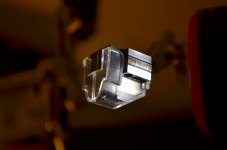
Other side:
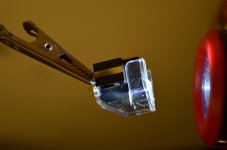
A bit of cotton was stuck on the stylus; I removed it later with a soft brush:
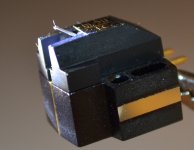
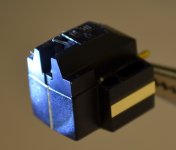
Here's the bottom and top:
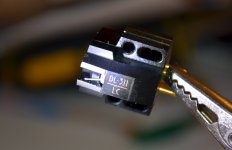
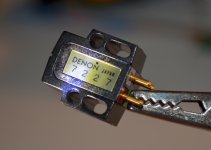
- Home
- Source & Line
- Analogue Source
- Simplistic NJFET RIAA